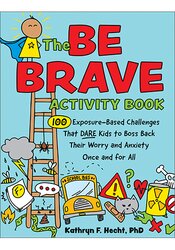Dodge the Worry Debate: A Guide for Therapists Working with Anxious Kids

As therapists, we often witness a familiar struggle between anxious children and their caregivers: a cycle of questioning, reassurance, and escalation that we can call “The Worry Debate.” A child might ask, “What if there’s a tornado?” and the adult rushes to offer comfort: “The weather forecast says we’re safe.” But the child isn’t satisfied. “But what if the forecast is wrong?” What starts as an effort to soothe quickly turns into a spiral of doubt and emotional intensity, with your child taking the podium and arguing the side of “Worry is right".
This pattern is understandable. It’s hard to watch children struggle with anxiety, and our natural impulse is to get that anxiety to go away. But reassurance backfires. The truth is, anxiety seeks absolute certainty– “How can I be SURE there won’t be a storm?” – and when that can't be provided (because life doesn't offer it), the anxious brain continues to poke holes in every answer. This is the heart of the Worry Debate: the need for a guarantee in a world where no guarantees exist.
In your sessions, you can guide both children and caregivers to sidestep this trap—not by shutting down the worry, but by shifting how it’s handled. Here’s how.
Step One: Answer Once, Answer Well
Rather than repeatedly engaging the content of the worry, encourage caregivers to offer one clear, calm, and honest response. The goal isn’t to convince the child that nothing bad will happen, but to provide accurate (uncertain!) information, and to model your own assessment of the safety of the situation. For example: “The forecast says today will be partly cloudy, and that rain is very unlikely.” You can coach caregivers on how to deliver this message using language that matches the child’s developmental level—simple, concrete, and grounded. Role-playing in session can be incredibly effective here, allowing caregivers to practice staying steady and brief in their responses.
Step Two: Don’t Reassure, Relabel as Worry
Once a response is given, shift focus away from the facts and toward the feeling that’s showing up. Help the child notice and separate from the feeling by externalizing the feeling, or naming and labeling it: “Sounds like Worry is getting loud today.” When children learn to label Worry (with a capital W!) and see it as something separate from themselves, they gain emotional distance and insight. You can reinforce this by using playful names like “the Worry Monster” or Be–Sure Bob, encouraging kids to talk back to it rather than argue with reality.
Step Three: Build Competence Instead of Certainty
It’s tempting to promise that everything will be fine. But instead of offering guarantees, help caregivers pivot toward messages of capability. Saying “You’ve handled tricky weather before, and I know you can do it again” communicates confidence in the child’s ability, rather than trying to control the outcome. During sessions, take time to reflect on the child’s past moments of bravery, or better yet, keep a list of “success stories” where the child faced a fear and handled the anxiety that showed up.
Step Four: Gently Shift Attention Toward What Matters
After labeling the worry and reinforcing capability, support the caregiver in guiding the child toward values-based action. That might sound like: “Worry wants to be in charge and wants us to keep focusing on it, but right now we’re going to the park—what do you want to do first when we get there?” This is not a distraction, but a redirection. You’re helping the child learn that worry doesn’t get to make all the decisions. In session, make a list with the child of all the fun things that they would like to do that Worry tells them to avoid. Then, work with the family to make a plan for practice taking that action despite uncertainty – cloudy–day picnic at the park, anyone? These “bravery challenges”, a.k.a. exposures, are the key active ingredient in the treatment of anxiety. With practice, the child will find that the uncertainty is easier to handle, and that those worry thoughts become less frequent, and less sticky.
The Big Picture
When we guide families to dodge the Worry Debate, we’re not ignoring the fear—we’re teaching children that worry thoughts are not an emergency, and we believe that kids can handle these thoughts and the feelings that go with them. Instead of chasing down every anxious “what if,” we help children and caregivers learn that uncertainty is part of life—and that they are capable of facing it.
Ultimately, our role is to help kids become the kind of people who can experience anxiety and still move forward. It’s not about eliminating fear. It’s about building the inner belief that they can handle what comes next, even if they don’t know exactly what that will be.

Blending the cutting-edge science of pediatric anxiety treatment with a whole lot of silly fun, each chapter offers a CBT-based introduction to a fear, followed by a series of playful and bravery-building dares (aka exposures!) to help kiddos go from scared to prepared.






